Behind the Line: Ctrl-Alt-GDC 2018
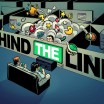
Ctrl-Alt-GDC is possibly my favorite part of GDC. While there may be more interesting or newsworthy displays here or there, Ctrl-Alt-GDC is always reliably presenting unique ideas that demonstrate new ideas for how people can interact with electronic media.
I experienced all of the entries this year and was very pleasantly surprised with some of them.
Striker Air Hockey (Guerrilla Nouveau)
Guerrilla Nouveau has been hard at work on a new touchscreen technique. We made air hockey to demonstrate the possibilities of this low resolution touch screen technique, but couldn’t resist throwing in some extras.
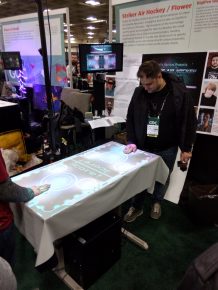
This looks exactly like what you’d expect from a novelty installation at a Dave and Busters. First of all, the description makes this sound like a huge touch screen, and it isn’t. It’s based off of a projector pointing down at the table. The control resolution did not appear to be great for table hockey. However there’s possibilities when cost and flexibility are considered for custom installations.
Too Many Captains (And Not Enough Wire) (Avi Romanoff, Giada Sun)
A game where two or more players work together to pilot a spaceship through outer space. The engineer has the controller, and they plug colored wires into panels on the game’s controller. However, the engineer can’t see the screen — they need to rely on the other players, the captains — to guide them to victory.
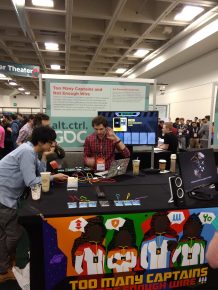
This game reminded me of SpaceTeam, or maybe Artemis Space Bridge Simulator. When I played I was the engineer, trying to figure out what everyone was saying, and prioritizing power allocation from that. It was frantic and fun.
Vaccination (Installation Required)
Two players must work together to keep the patient alive for as long as possible against the onslaught of bacteria racing towards the patient’s heart. One player is in charge of scanning the body, on the lookout for the bacteria and relaying what vaccine and where the other player, equipped with the injector, should administer.
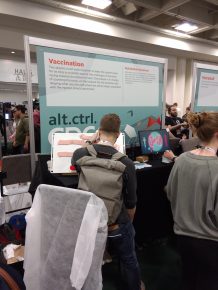
Video game version of Operation, but now it’s also Co-op. Kinda fun, but you can pick out most of the experience by looking at it.
Clunker Junker (HNRY)
Clunker Junker is an experimental arcade game in which two players attempt to keep their space transport intact as they outrun space pirates through an asteroid field. As the ship takes damage in-game, physical panels will fall off of the ships 4 main modules, disabling them until they are repaired using the custom-made repair tool. The tool boasts two main components. First, the specially made tip which must be used to connect to the 4 ship modules. Second, the uniquely fabricated crank which provides actual power and rotates the tip, allowing players to perform actions such as steering, changing turret direction, supercharging their engine, or repairing their hull.
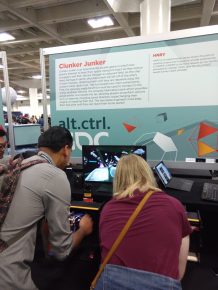
The description covers it. The blaster controls were broken when I played, and trying to boost the engine made it harder to steer. Also, the whole installation was a little low for me to be physically comfortable with it, but it was still a fun one to try out. The actual experience of trying to manage so much at once was a fun one, meaning that it has a compelling game experience within it.
Grave Call (Totally Not a Game Studio)
Grave Call is a time-based, asymmetrical multiplayer game based on communication between two players, one is buried alive and one is a police dispatcher. A phone holds clues for the coffin’s location, which has to be identified before the phone battery runs out.

This was a fascinating example of asymmetrical play. I played as the buried person and didn’t see the police dispatcher side. It’s a mad scramble to try to find something worthwhile on the phone to direct the dispatcher. Unfortunately when I played the wifi cut out the voice connection about half way through and we won only through luck. However, with some work this can be elevated next to games like Keep Talking and Nobody Explodes.
Living Orb (Jonathan Giroux)
Living Orb is a tangible game console, with which you can easily create your own enlightened games. The device is an sphere covered by LEDs. It’s like its surface is the screen! And you only control it by rotating it, that’s all. This allows for unique games!
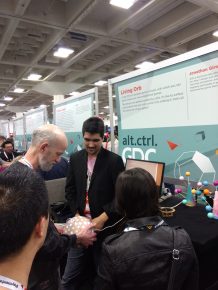
This is a concept build of something that could be an interactive, and possibly educational, toy. The demo was a maze, where “you” were a yellow dot, always on the top of the sphere. You rotate the sphere to move, navigating blue walls to reach a red end point.
Wind Golf (Pepijn Willekens)
A game where you play golf by blowing on physical sensors!
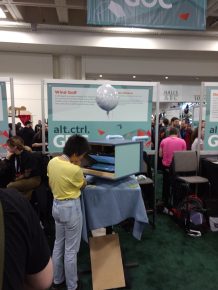
The players twist a box to change the angle, then blow into sensors on the left and right. You can’t blow straight, so you always have to angle. The 360 degree rotation made for an interesting virtual experience. Unfortunately when I played, the act of turning registered as blowing on the sensor due to the air moving over it.
Puppet Pandemonium (Fluffy Games)
A puppet show video game that uses the puppets as the controllers, and has an element of audience participation.
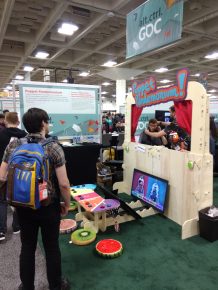
By far the most elaborate display this year. This game supported 7 players. 2 players controlled puppets of a puppet show, and the other players are the audience. This had actual puppets, and a stage, for the audience. On a screen, the puppet players are fed their lines like a teleprompter. The “show” then went into some games of appropriately, and increasingly, zany mechanics. I couldn’t quite tell what the audience was exactly supposed to do for all of the games, but I’m also not sure if that was the point. It was silly, interactive, crowd involving fun.
Disco is Dead! (Third Floor Games)
Disco is Dead! is a 2-player buddy cop comedy horror arcade game that follows the story of Reggie and Kenny — two disco-loving cops who must save their city from a zombie outbreak with their ultimate handy dandy weapon… slapping! The game plays with slappable zombie heads and disco ball controllers for a more immersive experience!
My picture was missing. This is courtesy Gamasutra.
A surprising level of plot presentation on this one, caricatures of 70’s disco people are cops running around hitting zombies, via zombie heads. You have a small area to register a hit, and you have to identify if you are slapping right, left, or down. There is also a power up mode that can be activated by touching a Disco Ball, and High Fiving. (This is the first of several games that involves physical contact with another player). Not too difficult, and it didn’t present much variety.
Voiceball (Alex Turbyfield, Stephen Borden, Ilya Polyakov, Talal Alothman, Ali Yaldrim)
Voiceball is like foosball played with your voice. Using microphones, players hit the ball with a waveform representation of their voice. Make sounds to create waves to hit the ball into the other player’s goal in this party game pitting your vocal skills against your friends.
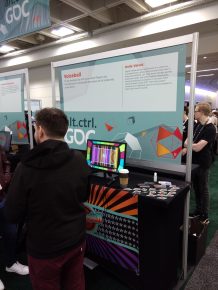
This one was a neat novelty. I was able to win a match, but I had trouble hitting a note that had a clean way to push on one side of the field. I heard someone with some operatic pipes playing this, and that was interesting. Another person said you could just make a loud noise and it would push everything everywhere, so as a balanced “game” it isn’t great. Like I said it was a neat novelty.
Wobble Garden (Robin Baumgarten)
Wobble Garden is a hand-crafted arrangement of sensing springs combined with reactive lighting. Players wobble springs to interact with the installation and play games. It creates a unique visual and tactile experience, and will be scaleable to a several meter large installation.

Not so much a game as an experience. There were dozens of door stop springs on a board, arranged in a tight hexagonal shape, each with an LED ring around the base. If you tapped one, it would radiate colors out to the surrounding springs. They also handed out rainbow diffraction glasses, which made everything much more striking. There was a sort of a game with this where the user had to follow lights presented, but that was clearly not the main point.
Unicornelia (The Sad Rainbows)
A game about the life of a young unicorn with an office job, played by mounting a horn on your head and inserting it into special motion-sensing compartments while also managing emotions via special pressure-sensitive pillows.
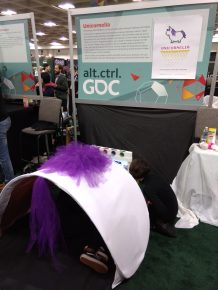
A game that’s more of a thought experiment about balancing your life. As a player you can touch 4 buttons with the unicorn horn to clear prompts that appear, or you can hit things inside to clear them out. Each of the 4 buttons represents a type of interaction (something like work, family, personal time) and after a time you’re given a readout of what you paid attention to. During the play there’s no apparent difference between the 4, just screens with different colors. Also, the buttons you could hit with the horn didn’t always register well. So, as a game, not the most intriguing, but as a thought experiment, not too bad.
Also… Xavier Woods was at GDC and I have seen no images of him playing this. I think that was a missed opportunity.
I think #Unicornelia would be of interest to The New Day. Looks like@XavierWoodsPhD is at GDC. You should check it out at the Ctrl-Alt-GDC exhibits.@UpUpDwnDwn#GDC #GDC2018 #GDC18 pic.twitter.com/dORQ5J2ncM
— Kynetyk (@KynetykKnows) March 22, 2018
Mark Wars (Matthieu Alves, Louis Bernot, Alessandro Cheinisse, Gaëtan Cloarec, Florian Eschalier, Matthias Johan, Pierre Llanusa)
Our intention was to make a game accessible for a wide audience using no screen and one instinctive button. With Mark Wars, using a marker pen, the players will be able to trace their own unique path! This path will be followed by the player’s small model ship (either a TIE Fighter or X-Wing) and can be altered by the opponent.
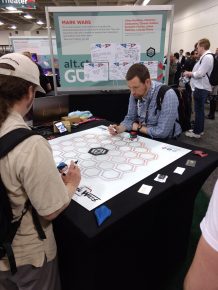
Have you ever seen one of those little robot toys that’ll follow a line you draw? This uses them to make a racing game. On a hex map, players take turns to draw courses to get to an end point. It’s more a board game than a video game, and an interesting concept. Actual game play suffers because the little cars don’t move constantly and independently, not in synch with the player turns, which can lead to a positional advantage that is difficult to overcome. Also, the cars choose between branches at random, which can be a big problem in a race. An interesting diversion made from available pieces, but not too impressive to me.
Pump the Frog (7 Holy Frogges)
Pump the Frog is a 2d-puzzle-platformer where you control the Frog and your environment, roll, slip and squeeze around the levels, devouring any fly in your path!
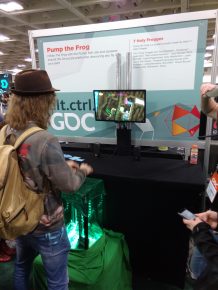
This one feels like a touch screen game, but it’s controlled with a bicycle pump. Use it to pump up a frog and modify the environment, and spin the handle to adjust other aspects of the environment like screws to close or open passages. You try to navigate levels to eat flies and special fruits. It feels like a pretty good arcade game.
Bot Party (Phoenix Perry and Frieda Abtan)
Bot Party in an interactive sound experience for humans. The bots have a problem. They have no way to communicate with their friends. Can you help? They need you to touch another human holding a bot. Through you the bots use the proprietary bot to skin to skin to bot communication protocol (BSSB) to send encoded secret messages to each other. Hold hands with other players to get the bot sound spectacular started!
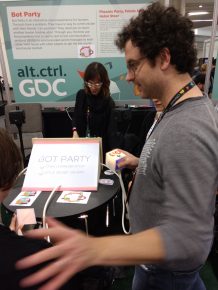
This was a game based on touching other people with a pound or high five, or really any skin contact. Each of 3 players is holding a box, when they light up, the players holding the lit boxes should touch. It can be in pairs or all 3. There is also some accelerometer element to it. I think we were each supposed to be moving our boxes in a certain way, but it wasn’t clear. It may have been too loud to get good audio feedback of our success with that aspect. A simple problem it had was that if the wrong pair touch, it will immediately fail and move on. This means if the players try to give what was the right response, it’s no longer what is being asked, so you tend to score 2 errors. There’s no refresh time.
This game was presented as a platform that could run different games. I’m not sure that there’s enough flexibility here for that, but I could be wrong. While I don’t expect it there could be a space alongside something like LeapFrog for this.
Yo, Bartender! (Kraken)
Yo, Bartender! puts you in the shoes of a modern day bartender mixing cocktails in a bustling city. Survive the night rush by mixing and serving as fast as you can while making sure you always have the orders right. Do you have what it takes to be a bartender?
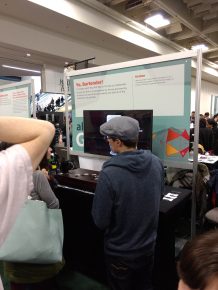
It’s like Bartender Hero, or Diner Dash at a bar with a big custom controller. Essentially a time management game as you try to mix and serve drinks. Not the most interesting thing here.
Doors to the City (Looking Glass)
An artist is lost in the divisions of his mind as he attempts to organize the vast arrays of his own creative process. The planets of his mind, NYC-LA-Newark-Oakland, take shape as he comes to battle them in their own respective ways.
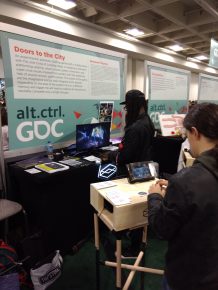
The best way to describe this is Tony Hawk plus Super Mario Galaxy. The simplicity of that description doesn’t convey the relative polish that this project displayed on the software side. They had 3 playable displays, 2 of which had 3d display elements to them. They were all controlled using a wired up Tech Deck skateboard as a controller. The controls were a little awkward, especially since it was being used pretty hard so it wasn’t too reliable when I got to it, but the core concept was pretty intriguing.
Lemonade (Jing Sun, Yaying Zeng, Yuchen Huang, Ziqiang He)
A two-player game in which each player controls one (real) water pipe they can use to control the angle and flow of virtual on-screen water pipes. Shoot lemons, avoid cupcakes, make lemonade!
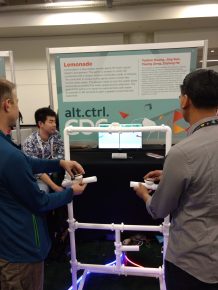
This had a nozzle and a valve for each player. You can control the angle of a nozzle on screen and how much water pressure you were firing with. Unfortunately the valve wasn’t responsive enough to manage the limited water pressure in an efficient way. The game itself wasn’t great and it came off more as a simple project.
Hi-5 Heroes (Bobby Lockhart and Marty Meinerz)
Hi-5 Heroes is a 2-player cooperative rhythm game where two people high-five, low-five, and fist-bump to the beat.
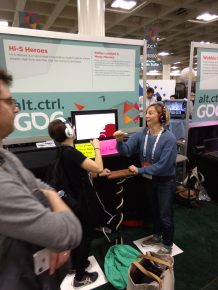
Another game involving touching the other player. Players try to high five in time following audio instructions. High five, pound, low five, or even “too slow” and you don’t touch. Later in the sequence the commands come in faster and more complex. The game actually has no way to tell if you’re following the details of instructions, though, only if the players are touching or not.
Scissors The That Than and Shcocoococo VS (Miyazaworks)
One is a a game played with huge scissors controller. Use the joystick on the left to move, press the button on the right to search nearest enemies, cut the enemies in order to survive. The other is a multiplayer game in which you use special soap bottle controllers (modified with a Raspberry Pi) to control an on-screen soap bottle bird. Depress the soap bottle nozzle, and the bird will shoot liquid at germs!

Scissors The That Than was not running when I was there, but Shcocoococo was. It was very simple in game play, graphical design, and play variety. Overall it reminded me of mid 90s share ware games. Angle a spray bottle up or down to move your character up or down. Squeeze to fire. If one player dies, the game is over.
Final Thoughts – The BTL Ctrl-Alt-GDC Awards
- Ambitious – Puppet Pandemonium
- Fun – Too Many Captains, Not Enough Wire
- Most Like A Released Game – Pump the Frog
- Intriguing – Wobble Garden
- Most Likely To Become A Real Product – Grave Call
- Honorable Mention – Doors to the City
Lets see if I can keep these categories consistent next year!

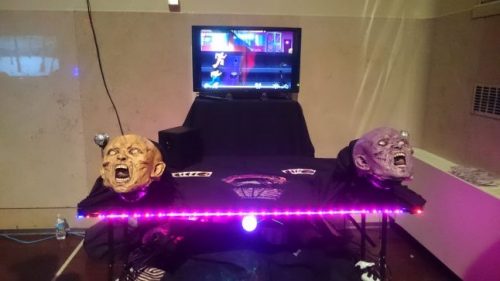


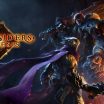
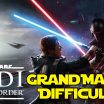


Leave a Reply